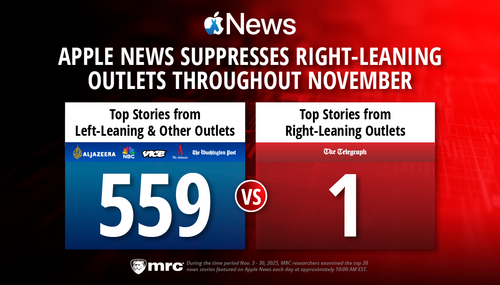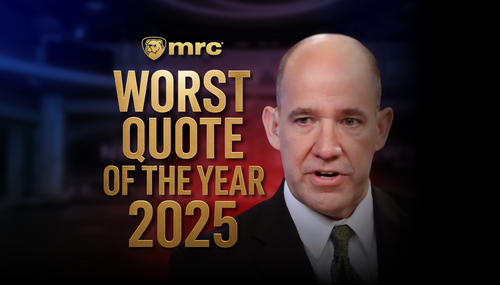 Early Tuesday night, Trump-appointed U.S. District Court Judge Trevor McFadden largely ruled in favor of the supposedly poor souls at the Associated Press (AP) in its ongoing legal fight against the Trump White House for barring them from their entitled, seemingly gilded spot in the White House press pool.
Early Tuesday night, Trump-appointed U.S. District Court Judge Trevor McFadden largely ruled in favor of the supposedly poor souls at the Associated Press (AP) in its ongoing legal fight against the Trump White House for barring them from their entitled, seemingly gilded spot in the White House press pool.
“Defendants shall immediately rescind the denial of the AP’s access to the Oval Office, Air Force One, and other limited spaces based on the AP’s viewpoint when such spaces are made open to other members of the White House press pool,” McFadden declared, adding the administration must also “immediately rescind their viewpoint-based denial of the AP’s access to events open to all credentialed White House journalists.”
In the 41-page ruling granting a preliminary injunction, McFadden said the multi-million dollar company has been financially “poisoned...by the Government’s discrimination” and had “its First Amendment rights” “violat[ted],” but made clear the White House doesn’t have “to grant the AP permanent access to the Oval Office, the East Room, or any other media event” or entitle the AP to “‘first in line every time’ permanent press pool access.”
Rather, he said, the White House must “put the AP on an equal playing field as similarly situated outlets” and “cannot...shut [the] doors to other journalists because of their viewpoints” and “[t]he Constitution requires no less.”
AP filed the lawsuit on February 21 after the administration made clear the liberal wire service was being booted from the press pool over its refusal to use the Gulf of America in its Styleguide, an all-but be-all, end-all rules for journalists at every major news outlet.
In intro of sorts, McFadden wrote (click “expand”):
Today, the Court grants that relief. But this injunction does not limit the various permissible reasons the Government may have for excluding journalists from limited-access events. It does not mandate that all eligible journalists, or indeed any journalists at all, be given access to the President or nonpublic government spaces. It does not prohibit government officials from freely choosing which journalists to sit down with for interviews or which ones’ questions they answer. And it certainly does not prevent senior officials from publicly expressing their own views
No, the Court simply holds that under the First Amendment, if the Government opens its doors to some journalists—be it to the Oval Office, the East Room, or elsewhere—it cannot then shut those doors to other journalists because of their viewpoints.
Following a court ruling’s standard format, he started with a history/logistical lesson which, in this case, detailed the differences between the press pool vs. press corps, a hard pass vs. a day pass, and — most critically — pool’s construction under the White House Correspondents Association (WHCA) versus its makeup following the AP ban and the White House’s February 25 announcement they would be taking over the pool’s schedule of rotations.
McFadden also explained “[n]ews wire services, like the AP, are syndicated outlets that distribute their text reporting and photography by ‘wire’ to subscribers across the country and the globe” and thus “‘guaranteed’ two of the 13 core sports in the pool” as originally determined by the WHCA.
Later, he noted “the AP indeed has been excluded from large events far more often than its peers” such as in the East Room and “its text reporters have been systematically and almost completely excluded from events open to the broader White House press corps since February 13, while its photographers have suffered curtailed access.”
He also ripped the White House for having singled out the AP and painted the liberal behemoth as left suffering in the cold (click “expand”):
The analysis is straightforward. The AP made an editorial decision to continue using “Gulf of Mexico” in its Stylebook. The Government responded publicly with displeasure and explicitly announced it was curtailing the AP’s access to the Oval Office, press pool events, and East Room activities. If there is a benign explanation for the Government’s decision, it has not been presented here. At the evidentiary hearing, the Government conceded that the record reveals viewpoint-discriminatory motives, so all indicators point to retaliation...All that remains is whether the Government’s conduct has chilled or adversely affected the AP.
The ramifications for the AP have undoubtedly been adverse. Start with photography. The AP’s total loss of access to the Oval Office and stifled East Room access has sent damaging ripples across its reporting capabilities. Put more bluntly, the AP is getting “absolutely slaughtered”...Though some other photographers have let the AP use a selection of their own photos out of solidarity, they are not providing it with the most desirable pictures...These images are qualitatively and quantitatively inferior to what the AP would produce itself...More, the AP does not get access to its competitors’ photos in real time, so whatever images it eventually uses are delayed...And this time lapse has a significant adverse impact on AP’s competitive profile...All told, as for photographing these events, the AP is “basically dead in the water”...Thus, there are not any “other sources” the AP can resort to as an adequate substitute....
This erosion of quality and capability is not limited to AP photojournalists—its wire reporting service for White House news is a shadow of its former self too. Text and print wire services “vigorously compete with each other to provide the fastest and most accurate news reporting” during and after the press pool events...Often this reporting is “instantaneous” and reporters can live-post breaking news alerts directly or notify their editors of important developments from the inside of a meeting or briefing.
To state the obvious, if the AP’s wire reporters are not in the room when news happens, they can hardly be the first to break the news. Instead, they are forced to wait and pick up whatever scraps of verifiable information they can find as they watch their competitors break the story first...True, the wire reporters sometimes get access to a video feed of an event...But reporting through secondhand sources simply does not allow for the “same level of completeness” in their reporting as if they had “been there in person”...They cannot look around the room and use all five senses to craft a unique message for publication. And, as Miller pointed out, reporters “don’t know what [they’re] not there to see”...Finally, and obviously, they cannot ask questions from outside a closed door. Those questions, if the President chose to answer, could lead to incisive and cutting-edge reporting that the AP cannot reproduce by watching from afar.
These disadvantages have poisoned the AP’s business model. As its ability to rapidly supply new photographs and breaking news has dwindled, the AP’s customers have expressed concerns and turned to other sources for their needs...These concerns also led an advertiser to cancel a $150,000 deal...The facts reflect the precarious realities of life in the fast-paced world of journalism: A delay in capturing photos and details of breaking news can be catastrophic.
McFadden spent a lion’s share focused on the Oval Office (and then other spaces) as “a nonpublic forum,” given its “a highly controlled location...shrouded behind a labyrinth of security protocols, and few members of the public will ever approach the Resolute Desk.” “Thus, the AP has no standalone right of access to the Oval Office.”
 However, in opening up public access, “restrictions must be reasonable and not viewpoint based,” which the judge found the administration as having done because of its Gulf of America holdout.
However, in opening up public access, “restrictions must be reasonable and not viewpoint based,” which the judge found the administration as having done because of its Gulf of America holdout.
He gave plenty of love to the AP — including longtime correspondent Zeke Miller — for the evidence it turned up to claim its inability to be ‘in the room’ had left them “irreparably harmed” its credibility and finances (click “expand”):
In sum, the Court credits the AP’s testimony and evidence that its text journalists have been systematically banned from large, limited-access events open to the entire White House press corps since, at the latest, February 13....The Court also credits the AP’s testimony and evidence that its photographers have experienced more limited access to such events compared to other hard pass holders.
(....)
AP journalists are engaged in full-fledged expression when they report from the Oval Office. AP photographer [Evan] Vucci described near-instantaneous transmission of photos to his editors when covering events in the Oval Office. The lag time between a picture’s creation and its publication online to the entire world is sometimes as short as “30 seconds to 45 seconds”...Real-time publication is so vital to his role that he is “hard-wired directly into” three mobile internet devices, each on a different network, to ensure he can always transmit from the White House...He also brings his cellphone into the Oval Office because “an editor or a reporter” may text him asking for specific photographic content—content he can provide on the spot by taking a photo and sending it in under a minute.
(....)
Vucci is not the only journalist who communicates live from the Oval Office. Print journalists sometimes text their editors “[i]f there’s huge news” so the editors can “send out [news] alerts in real time” to the public....Miller can draft news alerts on his phone “while the event is still going on”....He is also in constant contact with his colleagues “[a]t pretty much every event” he covers...He keeps a “running conversation” going where they all exchange “notes and feeds” as events unfold in front of them...When Miller is covering an Oval Office event, other reporters from around the world “can point out something interesting” to him and “respond in real time to an announcement”—all of which “help[s] inform” his reporting...Simply put, AP journalists are “speaking” from inside the Oval Office.
(....)
The AP provided abundant evidence that its First Amendment right to gather and quickly disseminate news about the President has been severely hampered by—and continues to be hampered by—the ban on press pool admission and the highly circumscribed access to limited-access events...And the AP has shown that it remains subject to viewpoint discriminatory exclusions from places that the Government has opened as nonpublic fora...Because the AP has shown that the ban “directly limits” its protected activity, it has established irreparable harm...
The AP’s irreparable harm is not limited to constitutional injuries. This situation has cut deeply into the AP’s business, both financially and in terms of lost opportunities...While solely financial harm is typically not irreparable, the dynamic can change in suits against the Government.
(....)
The AP has been economically hemorrhaging for the last two months, and its condition will only worsen as its customers flee to other news services absent injunctive relief.
(....)
The balance of equities and public interest also favor the AP. While “the White House surely has a legitimate interest in maintaining a degree of control over media access to the White House complex,” policy goals may never triumph over the Constitution...Put more simply: “enforcement of an unconstitutional law is always contrary to the public interest.”
How about sources of solace for the administration? McFadden suggested that, while their claim of a 2006 case between then-Republican Maryland Governor Bob Ehrlich and The Baltimore Sun wasn’t legal ground to bar the AP from the pool, it allows them ignore the AP.
Simply put, there’s nothing unconstitutional about refusing to acknowledge Miller or his colleagues when they ask questions.




